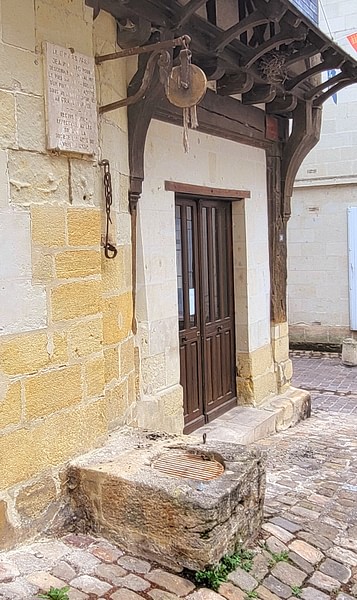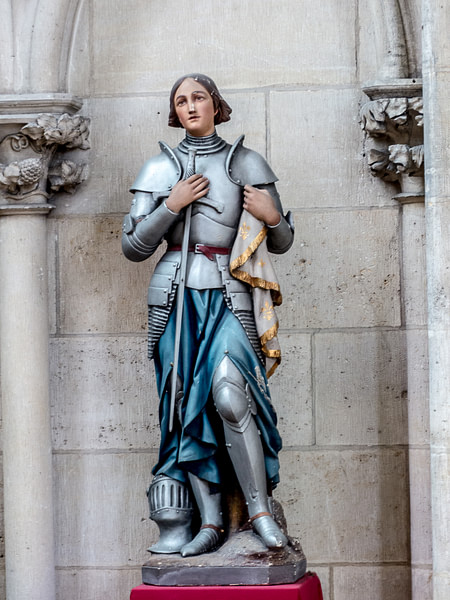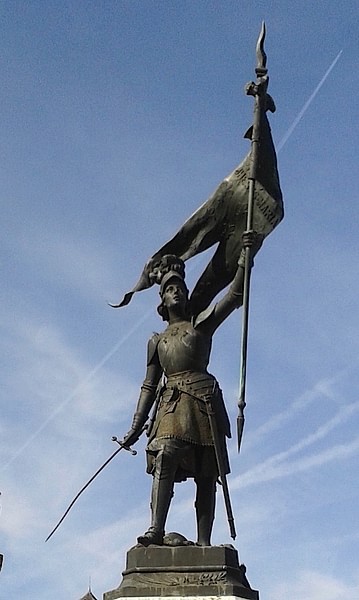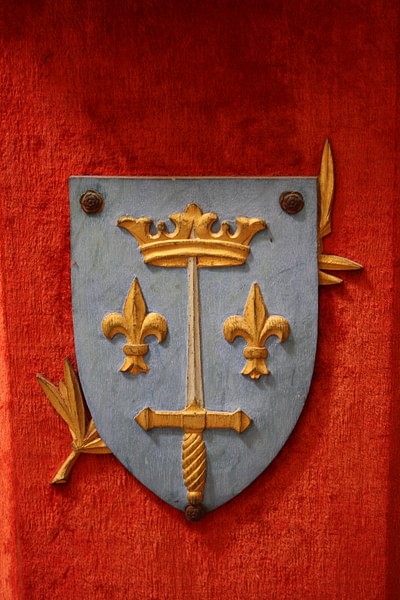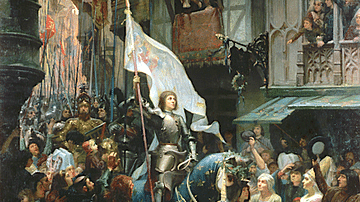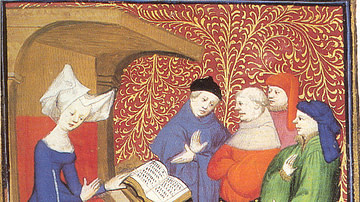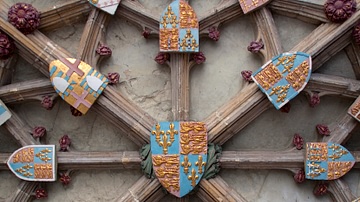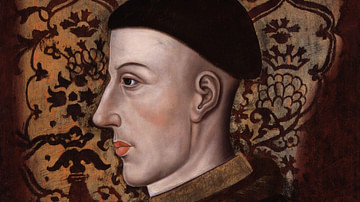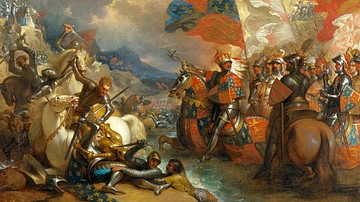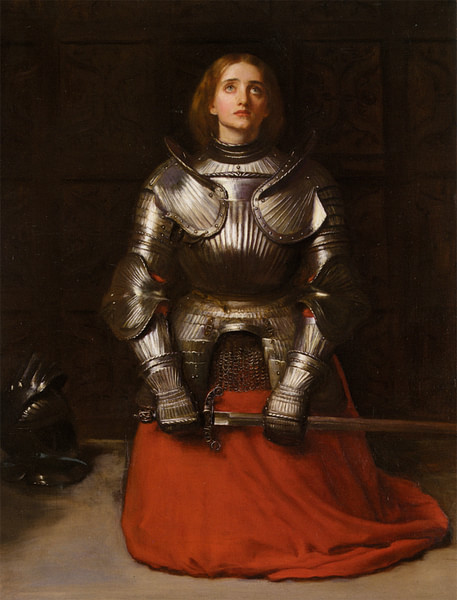
Joan of Arc (Jeanne D'Arc, l. c. 1412-1431 CE) was a medieval peasant who, claiming to receive visions from God, turned the tide of the Hundred Years' War in favor of a French victory. She was famously martyrd for standing by her claim of divine inspiration and later canonized as a saint.
She was born in Domremy, France to a peasant farmer but, at the age of 13, received a revelation while standing in her father's garden that she should lead the French to victory over the English and ensure that Charles, the dauphin (Charles VII of France, r. 1422-1461), was crowned at the traditional site of Rheims.
Joan succeeded in lifting the Siege of Orleans in 1429 and Charles was crowned at Rheims in July of the same year following the Loire Campaign. Joan was captured by the Burgundian allies of the English in 1430 and sold to them. The English could not prosecute a woman who claimed she was serving God but could not allow even the suggestion she was telling the truth because that would mean that God was on the French side of the conflict. They finally convicted her of being a relapsed heretic and burned her at the stake in May 1431.
The trial of Joan of Arc was reviewed as early as 1452, found to be invalid, and Joan was exonerated and proclaimed a martyr in 1456. She was later canonized and is one of the patron saints of France in the modern day.
The Hundred Years' War
The Hundred Years' War (1337-1453) was a conflict between France and England over the legitimate succession to the French throne. William the Conqueror led the Norman conquest of England in 1066, ruling England from 1066-1087 and establishing a French monarchy. The later kings of England still had estates and interests in France and periodically would make some gesture asserting their rights, disregarding the policies or wishes of the French king. The monarchy in France, therefore, wanted to cut England's power in their country while the English worked to increase the power they already had there.
In 1328, Charles IV of France (r. 1322-1328) died, leaving no male heir. Charles' sister, Isabella of France, claimed the French throne for her son, Edward III of England (r. 1327-1377) but her claim was denied because she was a woman and women were not allowed to make such claims. The throne passed to Charles' cousin, Philip VI (r. 1328-1350), and the antagonistic relationship of these two monarchs – Edward and Philip – finally ignited the war in 1337.
The war was not one long continuous conflict but a series of military campaigns, waged mostly on French soil, which consisted of hostilities followed by a truce and then re-engagement. Modern-day scholars have divided the history of the war into three periods for ease of study. Joan of Arc appears in the final period, known as the Lancastrian War (1415-1453) after the House of Lancaster, the ruling house of England at the time.
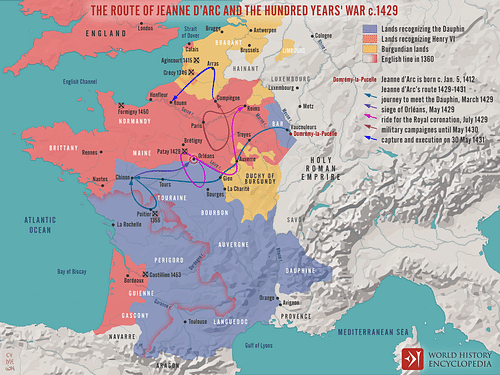
The Lancastrian War began with the stunning victory by Henry V of England (r. 1413-1422) at Agincourt where he defeated a numerically superior French force. Throughout the Hundred Years' War, English victories far surpassed those of the French and in this last phase of the war, that paradigm seemed it would hold following Agincourt. Henry V married Catherine of Valois, daughter of the sitting French king, Charles VI (r. 1380-1422), under the terms of the Treaty of Troyes (1420) and could now lay claim to the throne of France. Charles VI, however, had a male heir, the dauphin Charles, who maintained his right to the throne and was able to garner support for his claim.
English victories continued as Charles' supporters struggled to drive the English from France and legitimize his rule by crowning him king at Rheims, a city then held by the Burgundian allies of the English. The dauphin Charles only had any power in and around the city of Chinon, and his dwindling forces were defeated every time they took the field. It is during this period that Joan of Arc appears and reverses Charles' – and France's - fortunes.
Early Life & Visions
Joan was born in Domremy village to Isabelle Romee (l. 1377-1458) and Jacques d'Arc (l. 1380-1440). She had two older brothers – Jacques (sometimes given as Jacquemin) and Jean – and a younger brother and sister – Pierre and Catherine. Jacques d'Arc was a farmer, and the children would have all been brought up learning that trade.
At her later trial, the records of which are the main source of information on Joan's life, she claimed that she received a vision from God one day in 1425 when she was 13 years old. Saint Catherine, Saint Michael, and Saint Margaret appeared to her in her father's garden and instructed her to drive the English from France and see that the dauphin was crowned king at Rheims.
Joan never seems to have doubted that her vision was a genuine message from God, and yet it would be three years before she was able to begin her mission. It is possible that her family detained her or perhaps that she did not know how she was supposed to proceed, but this is speculation as no records exist on Joan's life c. 1425-1428.
In 1428, she appeared at the office of Robert de Baudricourt (c. 1400-1454), captain of the garrison of Vaucouleurs, a nearby town, asking to be taken to the dauphin. De Baudricourt laughed her away at least twice before she convinced him of the seriousness of her mission.
According to one version of the events, Joan returned to the captain's office in early 1429 and was able to tell him of a French defeat related to the Siege of Orleans before anyone could have known about it; thereby demonstrating her divine powers. The other version claims that Joan shamed him by addressing him loudly in public in a harangue on his lack of faith and refusal to believe God had sent her to liberate France. Whichever may be true, Robert de Baudricourt and some of his men escorted Joan to Chinon to meet the dauphin.
Meeting the Dauphin & Orleans
Charles VII had been apprised of Joan's visit and decided to test her by dressing as one of his courtiers and having one of them dress as the dauphin; if Joan were truly sent by God then she would know the true dauphin. When Joan entered the assembly, she went directly to Charles and addressed him as the dauphin, and when he protested and tried to trick her further, she held her ground. Later, in private, she is said to have convinced him of her legitimacy by telling him things he had only said to God in prayer.
Still, the dauphin had to make sure that Joan was not a witch trying to place him under her spell and so had her examined for orthodoxy and purity by an assembly of clergy at Poitiers. She was declared an orthodox Christian in good standing and presented herself to the dauphin again as the answer to his problems at Orleans.
Prophecies had been in circulation in France for years that a maiden in armor would arise from the region of Lorraine to save the country, and Joan now fulfilled that prophecy in traveling with the army to Orleans in full battle gear. Although she had thus far had nothing to do with the war and had never been involved in a single military engagement, the prophecy attached itself to her so firmly that she was welcomed in the city as a hero. The siege was conducted by the English in such a way that gaps were open to the city at various intervals which could quickly be closed when necessary. Joan and her forces were able to enter the city through one of these on the Loire river a few miles east of Orleans.
The Siege of Orleans had been underway at this point for five months, and the French had found no way to lift it. Scholars continue to debate Joan of Arc's significance in lifting the siege citing how new tactics were used in May of 1429 that had not been attempted before and how the defenders were open to new possibilities and so, by this reasoning, Joan's presence in Orleans may not have had as much impact as legend claims.
This reasoning is specious, however, in that it could and has been argued that Joan's arrival in Orleans, seemingly the fulfillment of prophecy, inspired the change in tactics and the sudden belief in the possibility of victory. Orleans was a pivotal city and of immense tactical and symbolic importance to both sides in the conflict. If the city fell, the French would most likely lose the war.
Joan immediately embraced her role as heroine by personally greeting the citizens of Orleans and going among them daily to encourage, inspire, and deliver food and supplies. The men in charge of the defense of the city routinely tried to keep her from the war councils but she would not be dissuaded and, if she could not participate, she could at least listen in.
Repeatedly, Joan called for direct action against key points in the English line and was ignored but continued patiently to suggest courses of action and to go among the people encouraging them and lifting their spirits. She rallied the troops and led them in an assault on the English position of St. Loup, which was successful and, the next day, backed by a militia of the citizenry which had responded to her inspiration, took part in another engagement which further broke the siege. Joan was wounded in the chest in these engagements but still persevered and carried her standard, inspiring others to fight on. The Siege of Orleans was lifted nine days after her arrival.
Other Engagements & Capture
Joan instantly went to work on a campaign which would pave the way for Charles VII to be crowned at Rheims but was met by opposition and continual objections. Rheims was held by the Burgundian allies of the English, deep in the heart of English-held territory, and Joan's plan of simply marching in, protected by the grace and strength of God, and taking the land seemed a naïve and impossible proposal to the commanders of the French forces. The prevailing wisdom of the day made clear that women had certain tasks they had been given by God and men had other and far more important responsibilities, and so women's advice on men's business was simply ignored. Joan was not only a woman but a teenage woman without any military experience or professional training in leadership.
Even so, she was able to convince command to agree to her suggestion as her victory at Orleans brought recruits from all over the country to join in the Loire Campaign of 1429. This initiative resulted in French victories from Jargeau to Meung, Beaugency, and culminating in the June victory at Patay, all inspired by Joan, even if she was not in a command position at each of them. The Loire Campaign steadily cleared the region on a march toward Rheims. The French were so successful that the Burgundians of Rheims surrendered the city and opened its gates without opposition and Charles VII was crowned king of France in the Rheims cathedral, in keeping with tradition and with Joan of Arc by his side, in July of 1429.
The great medieval French writer Christine de Pizan (l. 1364 - c. 1430), wrote her Tale of Joan of Arc to celebrate the liberation of Orleans (the first literary work written in Joan's honor and the only one in her lifetime) and must have been overjoyed at the coronation of the king. Records of the time suggest high spirits among the French everywhere as it seemed that the tables had finally turned and there was, at last, a chance that France might win the interminable war which by this time had been ongoing for almost a century. The French hopes were dimmed, however, when Joan was captured by the Burgundians in 1430 and sold to her English enemies.
Trial & Execution
Joan was held in the English-controlled city of Rouen where her trial for heresy took place. She should have been held in an ecclesiastical prison where she would have been tended to and guarded by women but instead was kept in a secular jail, constantly harassed and threatened by male guards. The trial, from the beginning, was a farce which a number of clerics initially refused to participate in until their lives were threatened by English authorities. Those who finally agreed to take part, however, were far from happy about it.
If Joan were telling the truth, then the English had been wrong in God's eyes for continuing the war and the English clergy had been wrong in supporting it. Joan had to be found guilty, and yet the evidence that God had directed her victories was irrefutable. With no experience in leadership or military matters, Joan had proven herself an exceptional strategist, winning every engagement she took part in. The judges knew she had been examined for orthodoxy and purity and had been found a good Christian and a virgin. In order to convict her, the tribunal would have to trick her into confessing she had lied about her visions and was guilty of heresy.
Joan was held in a military prison, shackled even in her cell and abused by her guards, and was led out to be questioned by the most sophisticated legal minds of her day. According to the transcripts of her trial, she ably defended herself, especially in the moment when the judges tried to trick her by asking if she believed she was in a state of grace. Since the church claimed that one could not know if one was in a state of grace, if Joan answered yes then she would be a heretic and if she answered no she would be confessing herself as guilty of not being in God's grace and so her visions would be invalidated. Joan slipped through their trap answering simply, “If I am not, may God put me there and, if I am, may God keep me there.”
Threatened with death by fire, she recanted her claim to have been directed by God to liberate France, but her visions returned to her and denounced her for trying to save her life at the expense of the truth. Joan withdrew her recantation and was sentenced to death under ecclesiastical law as a heretic. She was burned at the stake in Rouen, calling upon the name of Jesus throughout her execution, on 30 May 1431. To make sure that she was dead, the court ordered her corpse to be burned twice more and her ashes thrown into the River Seine.
Conclusion
Charles VII, for whom Joan had given her life, largely proved an unworthy monarch in almost every regard. He is generally regarded as weak-willed and apathetic, especially in the years prior to Joan's involvement with him, and the accomplishments of his 38-year reign are understood to have been inspired and encouraged by others and hardly worth the life which had been paid for his rise to power. Attempts had been made to free Joan, but none of them were orchestrated or authorized by Charles.
France would win the Hundred Years' War in 1453 and, although there have been many books through the years arguing otherwise, this was due to the inspiration provided by Joan of Arc more than any innovations of French military tactics. Even a cursory survey of the history of the Hundred Years' War prior to Joan's involvement makes clear that the French consistently lost more engagements than they won and the kinds of successful tactics which changed that paradigm appear after the victory at Orleans.
Shortly after her death, Joan's brothers Pierre and Jean 'adopted' a woman, Jeanne des Armoises, and presented her to the public as Joan, claiming she had escaped her captors at the last minute. The three made a good living off this scam for six years until word of Joan's survival at Rouen reached Charles VII who called for her to come to him. When the pseudo-Joan could not tell Charles what secrets she had told him in 1429, the fraud was revealed. No legal consequences followed, however, and the brothers – who had been ennobled by the crown in 1429 along with every member of Joan's family following Orleans – continued to prosper and Jeanne des Armoises married well.
Joan's father is popularly believed to have died shortly after his daughter's execution from grief, but records indicate he lived until 1440. Joan's mother continually petitioned the authorities for a reversal of the conviction which finally came in 1456. Joan's conviction was ruled invalid, and she was proclaimed a martyr for the French cause. Although modern-day scholars and experts have attempted to explain away her visions – most notably as mental illness – none have succeeded. Joan of Arc continues to inspire people in the present day as she did in her own time and is honored as one of the patron saints of the country she helped to save.
